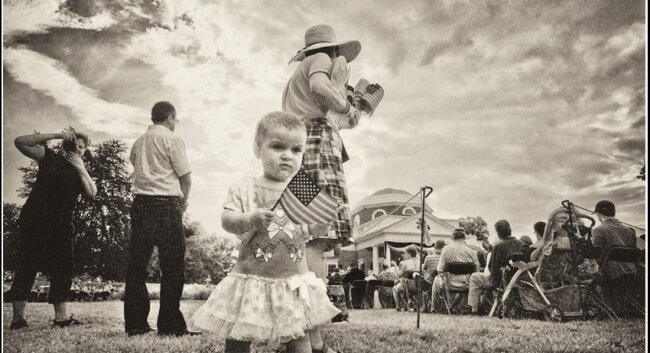Independence Day
Independence Day at Monticello included famed gymnast Nadia Comăneci and a young girl with a flag. Missing, however, were the silhouettes of two house-hugging liriodendron tulipifera that have been removed in recent years.
~
Commentator Bill Emory puts up a new photo nearly every day at billemory.com/blog.
Read more on: 4th of Julymonticello

7 comments
Bill --
As usual, good shot and good thought. You have the dynamic backward though. The recently deleted poplars weren't hugging the house. The house was hugging them, and that's why they survived as long as they did.
Jefferson had a penchant for putting pet plants where they were imperiled. At one point, the poplars that survived were part of a high rise hedge arrayed all along Monticello's terraces. A painting from about 1825 shows that clearly. But weather for which they weren't suited carried off the more exposed trees early on while those in the protective embrace of the house's angles stayed with us longer.
^^^^ somebody has too much time on their hands!
Ant, I admire your wealth of knowledge, but certainly that short house had nothing to do with the survival of those massive Tulip trees.
Toni-
I've often wondered what the mountain looked like in the old days. When I tour the house I ask about arboreal growth on the slopes of Monticello.
The docents typically say that Mister Tom had a view port cut out of impenetrable forest on the western side so he could watch construction at UVA through a telescope.
I counter with the suggestion that possibly Monticello officials are sensitive to the degradation of the western view shed, particularly the regional sewage authority at the base of the mountain on Charles Bankhead's (?) land. Possibly the Foundation has allowed the forest to grow in order to shield tourists from the industrial sprawl vista?
Wowee:
Not that such a crack deserves response, but FYI: Even though I would take a serious interest in history no matter what I'm doing for a living, historical research happens to be a big part of what I do professionally. In fact, I've just completed the second of two research assignments for a large regional firm with local holdings. My task was to compile a biography of a particular property, one that included both the people associated with it and its natural features.
Adelbert Enyedi:
On behalf of Thomas Jefferson, I say "Gotcha." Jefferson's first design for Monticello was a relatively "short" house that would have looked taller thanks to double galleries, a high peaked roof, etc. But his second design, one influenced by suburban villas he saw in France, was a much taller house that looks shorter thanks to an array of eye-fooling elements.
In addition, re Monticello's ability to protect close by trees from damaging weather, do please remember that when wind encounters an impenatrable object, it is deflected upward.
Bill:
Both images and visitor accounts from the 1820s and '30s, document groves of trees near the Monticello house. (And several also record severe damage done by unseasonable cold and giant hail in early 1832.) But when you read Cinder Stanton's descriptions of how Jefferson carved up the mountain's slopes for planting, you realize that much of what has been tree covered in our living memory was open land earlier.
As for viewshed concerns in more recent times, Dan Jordan pursued protection actively during his long directorship. That included lobbying in some cases -- State Farm's spread, for instance -- and actually buying affected property in others. And, of course, Monticello's surviving trees have been curated alongside its architecture and contents over the last century.
The trees you are talking about were cut down for the following reasons. The first is the tree on the south side took severe rot and was dangerous to the house.
The second tree I don't recall the exact problem but I do know it was becoming dangerous to the preservation of the house. Mr. Jefferson did have trees near the house just not nearly as mature or large because of the need to clear the mountain to building.
We always admired the huge tulip poplars (which are not related to poplars, really, but magnolias) flanking the house, and were sad when they came down. There is a wonderful local wood worker named Fred Williamson who was granted some of the wood to turn--we were so happy to purchase a bowl from the tree that Jefferson is believed to have planted.